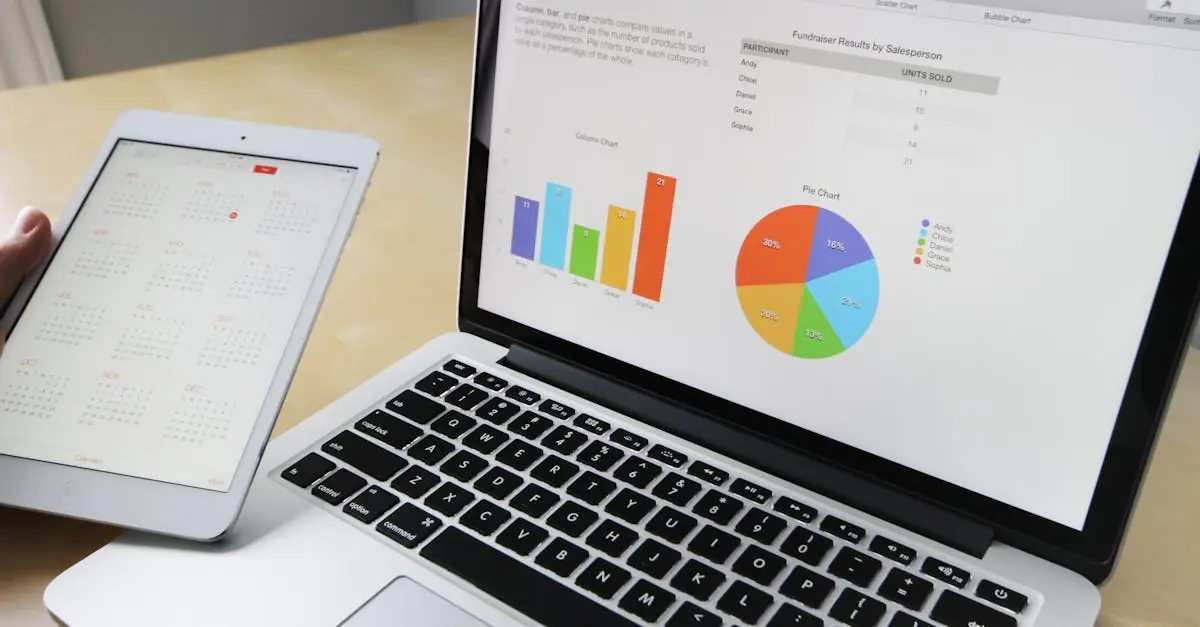In today’s fast-paced world, everyone’s chasing the elusive dream of a seamless workflow. If only there were a magic wand to wave away distractions and inefficiencies! Well, while there’s no fairy godmother in sight, a workflow boost can work wonders. Imagine turning that chaotic desk into a well-oiled machine, where tasks glide along like a well-choreographed dance.
Table of Contents
ToggleUnderstanding Workflow Boost
Workflow boost refers to the strategies and tools that enhance efficiency in work processes, helping individuals and teams achieve their goals. A streamlined workflow reduces distractions and eliminates bottlenecks, which ultimately fosters productivity.
Definition and Importance
Workflow boost signifies the improvement of processes that affect task completion and productivity. Organizations often seek this enhancement to increase output and decrease errors. A strong workflow leads to faster decision-making and better resource allocation. Important metrics such as time saved and project completion rates demonstrate workflow optimization’s value. Engaging in this optimization not only encourages accountability but also promotes a positive workplace culture.
Key Components of Workflow Boost
Several foundational elements contribute to an effective workflow boost. First, task management involves clearly defining responsibilities and deadlines. Next, automation reduces repetitive tasks, freeing up time for higher-level activities. Communication tools streamline collaboration, ensuring that all team members remain aligned. Finally, regular assessments identify areas for improvement, allowing for continual refinement of processes. Recognizing and leveraging these components can significantly enhance productivity and workplace satisfaction.
Benefits of Implementing Workflow Boost
Implementing a workflow boost yields significant advantages that enhance overall productivity. Organizations can experience a remarkable transformation through this approach.
Increased Efficiency
Efficiency sees a noticeable increase with the adoption of workflow boost strategies. Streamlined processes minimize time-wasting activities, allowing individuals to focus on high-priority tasks. Task management tools help teams prioritize effectively, ensuring that important deadlines are met. Automation of repetitive tasks further accelerates workflows, enabling employees to redirect their energy toward more strategic initiatives. Metrics demonstrate that organizations can reduce completion times by as much as 30% when adopting these practices. Additionally, faster decision-making emerges as teams quickly adapt to changing circumstances due to improved clarity in processes.
Enhanced Collaboration
Collaboration benefits enormously from a structured workflow boost, fostering a more connected work environment. Communication tools enable real-time information sharing, enhancing teamwork across various departments. Transparency in responsibilities encourages accountability, leading to smoother project execution. Regular assessments help identify collaboration barriers, allowing teams to address challenges proactively. Metrics indicate organizations experience a 25% increase in team cohesion when effective collaboration tools are in place. Improved collaboration creates an atmosphere where innovative ideas flourish, ultimately benefiting the entire organization.
Tools and Technologies for Workflow Boost
Automating tasks and managing projects are essential for enhancing workflow. A variety of tools exist that can significantly streamline processes, thus helping teams operate more efficiently.
Automation Software
Automation software eliminates repetitive tasks, freeing up valuable time for employees. Tools like Zapier and Integromat connect applications, enabling seamless data transfers without manual intervention. Metrics indicate that automation can reduce task completion time by up to 30%, allowing teams to focus on more strategic activities. Furthermore, such software minimizes human error, leading to improved accuracy in processes. With real-time updates, team members stay informed, creating a more agile working environment.
Project Management Tools
Project management tools provide structure to collaborative efforts, enhancing accountability among team members. Platforms like Trello and Asana assist in organizing tasks, tracking progress, and setting priorities clearly. By defining roles and responsibilities, these tools support efficient workflow and encourage transparency. Organizations using project management software report a 25% increase in team cohesion, further boosting overall productivity. Real-time communication features enable quick adjustments, ensuring projects stay on track and deadlines are met consistently.
Best Practices for Achieving Workflow Boost
To achieve a workflow boost, implementing best practices is essential. Focusing on identifying bottlenecks and adopting continuous improvement strategies can dramatically enhance productivity.
Identifying Bottlenecks
Recognizing bottlenecks is crucial for optimizing workflow. Analyze processes to pinpoint areas that slow down work, such as manual tasks or unclear responsibilities. Gathering input from team members often reveals obstacles that hinder efficiency. Prioritizing these issues leads to more streamlined processes and saves time. Tools like process mapping can provide clarity on workflow dynamics, helping visualize where delays occur. Addressing these bottlenecks can reduce project completion times significantly, allowing teams to focus on high-priority tasks and achieve deadlines more consistently.
Continuous Improvement Strategies
Embracing continuous improvement strategies fosters a culture of efficiency. Encouraging regular feedback from team members helps identify areas needing enhancement. Implementing new tools or workflows based on this feedback can lead to measurable improvements. Setting specific goals, such as increasing task completion rates by 20%, motivates teams to strive for excellence. Encouraging training and skill development also ensures team members stay updated with the latest practices. Utilizing metrics to assess progress offers insights into effectiveness, driving ongoing adjustments and enhancements for even better outcomes. With these strategies, organizations can cultivate a dynamic, adaptive work environment.
A workflow boost is essential for navigating today’s demanding work environment. By implementing effective strategies and tools teams can transform their productivity levels and create a more organized workspace.
Streamlined processes minimize distractions and enable individuals to focus on high-priority tasks. The right tools not only enhance collaboration but also foster a culture of continuous improvement.
As organizations embrace these changes they position themselves for greater efficiency and innovation. Investing in a workflow boost isn’t just about improving metrics; it’s about creating a workplace where everyone can thrive and contribute to collective success.








